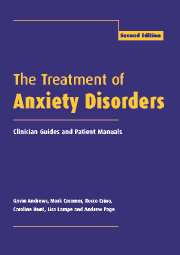Book contents
- Frontmatter
- Contents
- List of authors
- Preface to the second edition
- Abbreviations
- 1 Read me
- 2 General issues in anxiety disorders
- 3 General issues in treatment: Clinician Guide
- 4 Panic disorder and agoraphobia: Syndrome
- 5 Panic disorder and agoraphobia: Treatment
- 6 Panic disorder and agoraphobia: Clinician Guide
- 7 Panic disorder and agoraphobia: Patient Treatment Manual
- 8 Social phobia: Syndrome
- 9 Social phobia: Treatment
- 10 Social phobia: Clinician Guide
- 11 Social phobia: Patient Treatment Manual
- 12 Specific phobias: Syndrome
- 13 Specific phobias: Treatment
- 14 Specific phobias: Clinician Guide
- 15 Specific phobias: Patient Treatment Manual
- 16 Obsessive-compulsive disorder: Syndrome
- 17 Obsessive-compulsive disorder: Treatment
- 18 Obsessive-compulsive disorder: Clinician Guide
- 19 Obsessive-compulsive disorder: Patient Treatment Manual
- 20 Generalized anxiety disorder: Syndrome
- 21 Generalized anxiety disorder: Treatment
- 22 Generalized anxiety disorder: Clinician Guide
- 23 Generalized anxiety disorder: Patient Treatment Manual
- 24 Posttraumatic stress disorder: Syndrome
- 25 Posttraumatic stress disorder: Treatment
- 26 Posttraumatic stress disorder: Clinician Guide
- 27 Posttraumatic stress disorder: Patient Treatment Manual
- 28 Conclusions
- References
- Index
8 - Social phobia: Syndrome
Published online by Cambridge University Press: 05 August 2016
- Frontmatter
- Contents
- List of authors
- Preface to the second edition
- Abbreviations
- 1 Read me
- 2 General issues in anxiety disorders
- 3 General issues in treatment: Clinician Guide
- 4 Panic disorder and agoraphobia: Syndrome
- 5 Panic disorder and agoraphobia: Treatment
- 6 Panic disorder and agoraphobia: Clinician Guide
- 7 Panic disorder and agoraphobia: Patient Treatment Manual
- 8 Social phobia: Syndrome
- 9 Social phobia: Treatment
- 10 Social phobia: Clinician Guide
- 11 Social phobia: Patient Treatment Manual
- 12 Specific phobias: Syndrome
- 13 Specific phobias: Treatment
- 14 Specific phobias: Clinician Guide
- 15 Specific phobias: Patient Treatment Manual
- 16 Obsessive-compulsive disorder: Syndrome
- 17 Obsessive-compulsive disorder: Treatment
- 18 Obsessive-compulsive disorder: Clinician Guide
- 19 Obsessive-compulsive disorder: Patient Treatment Manual
- 20 Generalized anxiety disorder: Syndrome
- 21 Generalized anxiety disorder: Treatment
- 22 Generalized anxiety disorder: Clinician Guide
- 23 Generalized anxiety disorder: Patient Treatment Manual
- 24 Posttraumatic stress disorder: Syndrome
- 25 Posttraumatic stress disorder: Treatment
- 26 Posttraumatic stress disorder: Clinician Guide
- 27 Posttraumatic stress disorder: Patient Treatment Manual
- 28 Conclusions
- References
- Index
Summary
Clinical description
Social phobia is characterized by phobic anxiety and avoidance of social or performance situations. There is fear of scrutiny, of doing or saying something that would be embarrassing, and of being seen to be anxious. Central to the disorder is an underlying fear of negative evaluation (Beck et al., 1985;Liebowitz et al., 1985;Lucock and Salkovskis, 1988; Mattick and Peters, 1988; Mattick et al., 1989). Both the probability and anticipated detrimental consequences (cost) of negative evaluation are exaggerated. Social phobia for many patients is a chronic and disabling condition, with a significant morbidity in terms of personal distress, failure to achieve full social, occupational and personal potential, and significant psychiatric comorbidity. Cognitive, behavioral, and physiological aspects of the disorder have been recognized.
Individuals with social phobia experience many of the same anxiety symptoms as people with other anxiety disorders. However, the symptoms that are most troubling are those which are most visible to others: 77% reported blushing, sweating or trembling as an accompanying symptom in one study (Mersch et al., 1995). Individuals with social phobia worry that these symptoms indicate to others that they are anxious. They worry that if they are viewed as being inappropriately anxious they will be evaluated negatively.
Avoidance is the most prominent behavioral symptom of social phobia. Many patients will avoid the feared situations when possible, but will endure with intense anxiety when the negative consequences of avoidance are perceived to outweigh the negative consequences of attending. Social situations that cause anxiety may have primarily an interactional focus (e.g., initiating and maintaining conversations, meeting or “getting to know” others) or a performance focus (e.g., public speaking, presentations in meetings and tutorials, writing or signing one's name in front of others). Situations that involve actual or possible scrutiny may also trigger anxiety (e.g., standing in line, using public transport, using public toilets, using the telephone when others are around, eating or drinking in public, crowded situations including shops and cinemas). Most patients with social phobia fear more than one situation (Turner and Beidel, 1989;Manuzza et al., 1995).
Classification, subtypes and relationship to avoidant personality disorder
Social phobia has relatively recently been recognized as a diagnostic entity. Problems of social anxiety had often been thought of as an aspect of personality (Turner and Beidel, 1989).
- Type
- Chapter
- Information
- The Treatment of Anxiety DisordersClinician Guides and Patient Manuals, pp. 148 - 163Publisher: Cambridge University PressPrint publication year: 2002



